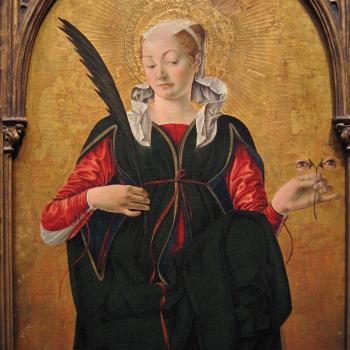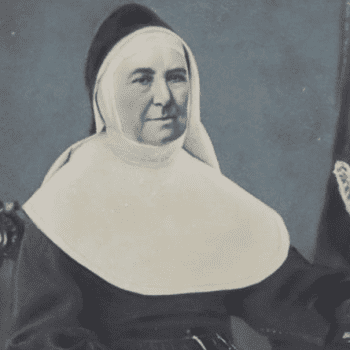
You might say that, without the traditionally comedic conclusion, I, along with many other member of Catholic Twitter in far more notable ways, have
Now realized for the first time [our lives] the vital Importance of Being Earnest.
If you want to learn the specifics of the perhaps most upsetting and unfunny Bunburying episode I have ever personally seen occur, that story is most properly Chase Padusniak’s to tell. Sufficient for this post, I will simply recap that there was a Twitter handle for @ThisCatholicGirl, an ostensibly 23 year old Catholic student and Catholic social media celebrity of sorts. She was witty and intelligent and very much the millennial and pious and all the things Chase mentions as well (since she was in a “relationship” with him). She was also wasn’t real.
Having set the stage, I’d like to back up and make a somewhat different beginning. Today is the Feast of the Exaltation of the Holy Cross. In this feast, we look on the Cross as the Church preaches Christ Crucified, and,
If it is impiety that looks on, it laughs at the King bearing, in place of His kingly rod, the tree of His punishment; if it is piety, it sees the King bearing the tree for His own crucifixion, which He was yet to affix even on the foreheads of kings, exposed to the contemptuous glances of the impious in connection with that wherein the hearts of saints were thereafter to glory. (St. Augustine, Tractates on the Gospel of John).
We celebrate Christ who gave up His own life for us so that through Him we might be saved and made free. Not some idealized version of ourselves, but we, in all our flesh and blood weakness and reality.
It is for this reason—Christ’s radical act of salvific love wrought in His own Flesh and Blood—that St. Paul writes to the Corinthians that it is “not I, but Christ who lives in me.” The Christian call, the universal call to holiness, is an iconic vocation. We are called through our Sacramental life to cast off our sins and take into ourselves the Spirit, who is the principle of our participation in Diving Life. In Heideggerian terms,* if we are temples of the Holy Spirit, that Spirit, dwelling in our soul, begins to build us into conformity with Christ. My friend Justin Tse, being the Eastern Catholic that he is, mentioned to me that icons are, in the Eastern tradition, written with a skewed perspective. I wonder if this is to help us remember that it isn’t a matter of mirroring the saint before us, but rather that the skewing allows us to pierce into the soul of the saint and realize that this saint loved God so well because it was not her, but Christ who lives in her.
This isn’t just a reality for saints—manifesting Christ I mean. It is what should be a reality for us all, the saints are simply the ones in whom this reality was clear. They diminished so that Christ might increase; in doing so, the saints became more themselves, more particular, and more clearly the persons God made them to be.
As I consider ThisCatholicGirl in light of Exaltation of the Holy Cross, I am going to be honest—this is a conversation I am hesitant to have, because behind the public personas of the handle and Chase’s blog, there are at least two very real and very hurt people. But, there is also the public nature of this deception—I too had interacted with her on Catholic Twitter, though without the degree of investment and consequent suffering that others are going through. And yet, as I learned the truth and talked with others about it, I couldn’t manage to shake the thought: is what she did so different from what I have done in some ways, except in terms of degrees?
What I mean is this: at root, the person behind ThisCatholicGirl looked at herself and, for whatever reason, she found her real self to be lacking. Rather than be that person, she crafted a public ideal. She was the sort of ideal whom the gentlemen would want to engage with and whom the ladies would want to be: intelligent, pious, witty, edgy, cool, artistic, beautiful, social, beloved. She wasn’t just the ideal of her creator— ThisCatholicGirl was an ideal for many of us. Let he or she who hasn’t instagrammed a picture of themselves for effervescent likes cast the first stone. ThisCatholicGirl’s creator wasn’t shocking or evil so much as she was profoundly and terribly human.
In her constructed persona—in all of our carefully crafted characters and personas who are social and funny and beloved and never have feelings of doubt or loneliness or failure or moments of ugly crying—we craft an ideal and strive to be that. We don’t see ourselves as we are—as the persons God made us to be. Instead, we make icons out of what we want to be, and projecting that image outside of ourselves, we try to conform to what we wish we were, rather than being the person we actually are.
Yet, Christ didn’t come to save ideals—Christ came to save persons. Christ came not for the righteous, but to call sinners to repentance.
I have suspicions that we actually can’t know an ideal abstractly. What I mean is that we can know and love persons, and from those persons we know and love, we can come to understand more abstracted ideals. But, those ideals aren’t personally subsisting. Those ideals are not persons. Those ideals are not redeemed.
But, who doesn’t like perfection? Ideals have the advantage over persons in that they come with carefully curated baggage. They aren’t messy, or no more so than crafts the aesthetic we desire. They are neat, clean, glamorous, and terrible in their stark, dehumanized imaginings. We set our ideals beyond us, and when we aren’t able to be that person, because no one is always happy or because, in the extreme cases, we are not 23, a student, and single, we conceal ourselves still further. We become convinced: if people love that ideal, we must, in our own persons, be all the less worthy of love, all the more alone, because that ideal is so beloved. In the sphere of public personas, this public and perfected ideal person can be all the more tempting, and all the more possible to construct.
When the public sphere exalts the public persona, rather than Christ Crucified, the public fails to skew the icon to find the truth, because the public also wants that ideal to be real—perhaps so we can become that ideal as well. I am a human person behind this blog. If you read this blog to find me, to follow me, to idealize me let me say this to you now: stop. I can’t save you. I can’t even save myself. No blogger, no online personality, no instagrammed filter, will do anything but let you down. Do not put your faith in us. Do not follow us. Put your faith in Christ Crucified. Follow Christ Crucified. Love Christ Crucified. If there is anything I have said or done well, that any of us has said or done well, allow me to pull back the veil: it was not us, but Christ Who lives in us.
If we become icons, it can only be through Christ being in us. Christ too is a Person. The Person of the Holy Spirit will literally come and dwell in us, in the fullest linguistic sense of literally. If you think you are not lovable as you are—join the club. None of us are except that while we were still sinners, God loved us and sent His Son to die for the ungodly. The great joy isn’t that any of us becomes perfect or idealized in Christ. The great joy is that we can become icons: we can become who we ought to be by revealing Christ as the One Who Loves Us while we were sinners, Who offers us the grace to know wholly as we have been wholly known, to love truly as we have been truly loved.
I hope ThisCatholicGirl is able to know this. I hope you are able to know this. I hope I am able to know this. Perhaps we might ask whether there wasn’t something revelatory in that handle after all. ThisCatholicGirl might not have been the person El Howard. That girl never existed. But everything we set ourselves up to be an ideal, an icon of our own hopes and desires, we, each of us, look an awful lot like her in our lack of reality. In some ways, the most terrible truth ThisCatholicGirl showed us is the mirror.
In her lack of particular, personal, actual existing, it seems tragically true to ask: if she is nobody in particular, then isn’t it true this persona could be any, if not all of us? In some way, haven’t we all been ThisCatholicGirl? Maybe we didn’t hurt as many people and in such a public way. Maybe she is better than us in terms of platform, or we are better than her in terms of limiting the damage and not getting caught. But, if we are not striving to live our lives as revealing ourselves in Christ, to be a kind of living icon, to skew towards Him and not ourselves, it seems true to say that we might all be ThisCatholicGirl at times: we might all be merely an ideal.
Today, be you, because Christ lives in you and loves you. Christ came to call you, not your constructions, to salvation. You, the existing, enfleshed, human person are, by the mere fact that Christ loves you and calls you to sanctity, so much better and more wonderful and more lovable than your ideals.
*Which for once are actually clarifying. See Poetry, Language, Thought.












